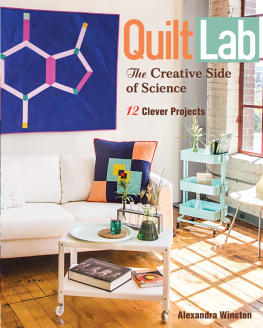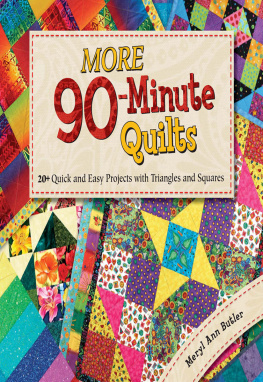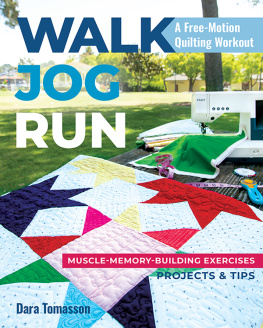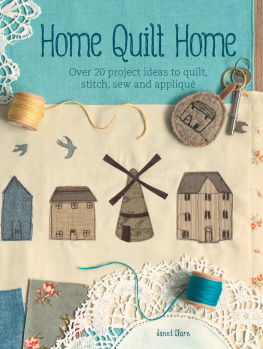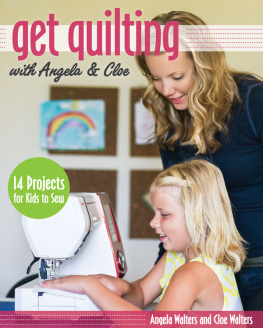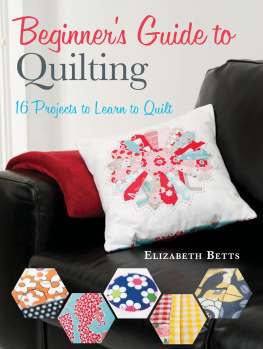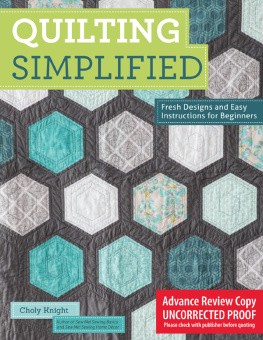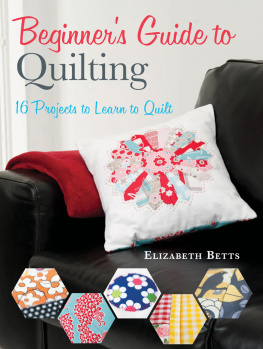Publisher: Amy Marson
Creative Director: Gailen Runge
Art Director: Kristy Zacharias
Editor: S. Michele Fry
Technical Editors: Helen Frost and Debbie Rodgers
Cover/Book Designer: April Mostek
Production Coordinator: Jenny Davis
Production Editor: Joanna Burgarino
Illustrator: Kirstie Petterson
Photo Assistant: Mary Peyton Peppo
Photography by Diane Pedersen and Nissa Brehmer of C&T Publishing, Inc., unless otherwise noted
Dedication
To Josh, whose opinions, support, and knowledge were invaluable to making this book (even if I seemed to ignore them all)
Acknowledgments
Big thanks to everyone who helped me along the way!
Mom, who taught me how to sew and who gave me my creativity and craftiness
Roxane Cerda, who dug through a stack of proposals and picked mine
Michele Fry, who answered tons of silly emails from me
My team: Joanna, Helen, Debbie, Jenny, Nissa, Diane, Kirstie, and everyone else at C&T who checked my work and brought this book to life
Kate McKean, agent extraordinaire
The ladies of QG, who keep me up to date on whats hot, inspire me constantly, and make sewing fun
My bloggy friendsAmanda, Darcy, Lindsey, and Melodywho encouraged me to keep going and shared their awesome advice and opinions
Free Spirit (freespiritfabric.com), who generously donated solids that were a pleasure to sew with
Introduction:
Where Science Meets Sewing
science |s ns|e nounthe intellectual and practical activity encompassing the systematic study of the structure and behavior of the physical and natural world through observation and experiment
I love geeky things. I watch video games (yes, watch not play) and sci-fi shows. I adore math so much that I teach it. I even used the theme from The Legend of Zelda as the recessional song at my wedding. But science has never really been my best subject. In fact, my first C was in science class.
In high school I took a slight interest in chemistry, but only so far as to memorize what charge each element haspositive and negative numbers are a concept Im more comfortable with. I always made someone else do the dissection in biology.
To me, science is overwhelming and complex, enormous and miniscule, concrete and nebulous. It encompasses a myriad of topics, from the body and nature to computers and synthetic materials. Science is about people and behaviors and planets and space and numbers and computers. I dare you to look up fields of science in Wikipedia and not be overwhelmed.
If you read science magazines as I do, then you have probably noticed the graphics. Oh, how I love looking at the pictures! My favorites used to be the pictures of the universe with all those colorful cloudslike looking at a dream. Then, not too long ago, my husband burst my bubble and told me that thats not how space really looks! Special cameras capture different light wavelengths, and then those (sneaky!) scientists assign colors.
Thats when it occurred to me: Science is more than understanding all the theories and rules; science is about communicating these ideas with everyone who is interested. Science is about our surroundings and us. Those lovely pictures of space communicate what we cant see with the naked eye; they show us layers of information. A picture is worth a thousand words, and science is a deeply graphic discipline. What words cannot convey, images can. Images and graphs reduce the data to a form that everyone can appreciate and learn from.
I have taken many disciplines and ideas and turned them into quilts, trying to make the designs practical, educational, and attractive. Ive drawn on basic ideas such as the states of matter and advanced concepts such as calculus; I even sneaked in my love of video games and photography. My quilt Aperture Science () is directly inspired by the game Portal. Each quilt has a story, a lesson, or an idea that underlies the design and fabrics and gives the quilt extra depth.
Disclaimer!
Im a quiltermath teacher, not a scientist. With these designs I have taken some artistic liberties and encourage you to do the same. Its better to create a design that you love than have a technically correct design that is a headache to create. Similarly, Ive simplified the math and science explanations. People spend their entire lives studying these topics and becoming experts; Im reducing that to a paragraph. Like with my middle school students, Im hoping to instill enough curiosity in you that youll look into some of these topics further.

Geometry
I love geometry. There, I said it. If you dont love it, I would guess its because of those pesky area and perimeter calculations. Luckily, we dont need those. We just need to know our shapes and embrace their unique qualities.
One of the first things you are usually told in a beginning drawing course is that basic shapesrectangles, triangles, circles, ovalscan be used to draw just about anything. The same shapes form our quilts. Looking at the most traditional quilts, we see designs such as Log Cabin and Courthouse Steps made from a square and rectangles. The Ohio Star combines squares and triangles. Flying Geese are just triangles. The Nine-Patch is made up of nine squares and the Drunkards Path comprises quarter circles.
Rectangles
The rectangle is perhaps the most important shape we will be using. Because of the right angles, rectangles come together easily. And just so were clear, the square is just a special rectangle that has four equal sides. These are going to be our building blocks. Even when we make blocks of other shapes, we will square them up before sewing them together. Squaring up means making the corners into right angles. Figure A

Triangles
Triangles offer more variety than rectangles because the angles change. Triangles can be considered
equilateral: all sides and angles have the same measure
isosceles: two sides and two angles have the same measure
scalene: no sides or angles have the same measure
No matter what kind of triangle you end up with, though, the three interior angles will always add up to 180. Figure B

The most common triangle in quilting is the isosceles right triangle. With one right angle and two equal sides, these are often made by cutting a square in half along the diagonal. Some refer to these as half-square triangles (HSTs). Cutting a rectangle on the diagonal will result in a half-rectangle triangle (HRT). Because you still have the 90 angle but all of the sides are different lengths, this is a scalene right triangle. Figure C
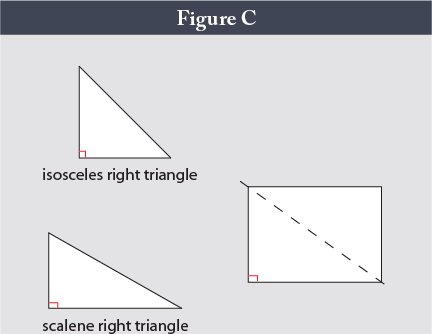
You may also remember something about the Pythagorean theoremmaybe just the name. This is used with right triangles (and HSTs) and comes in handy when you are trying to figure out side lengths and how big to make your blocks. I have included a handy table in the Appendix, but heres the formula in case you cant find the size you are looking for.
Formula: a2 + b2 = c2
Sides a and b are always the two sides (called legs) that make the right angle; its OK if you switch them. Side
Next page
